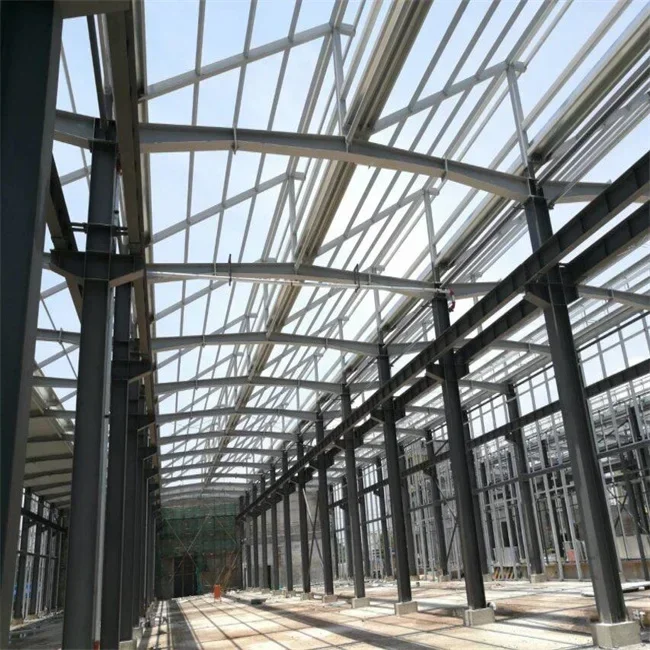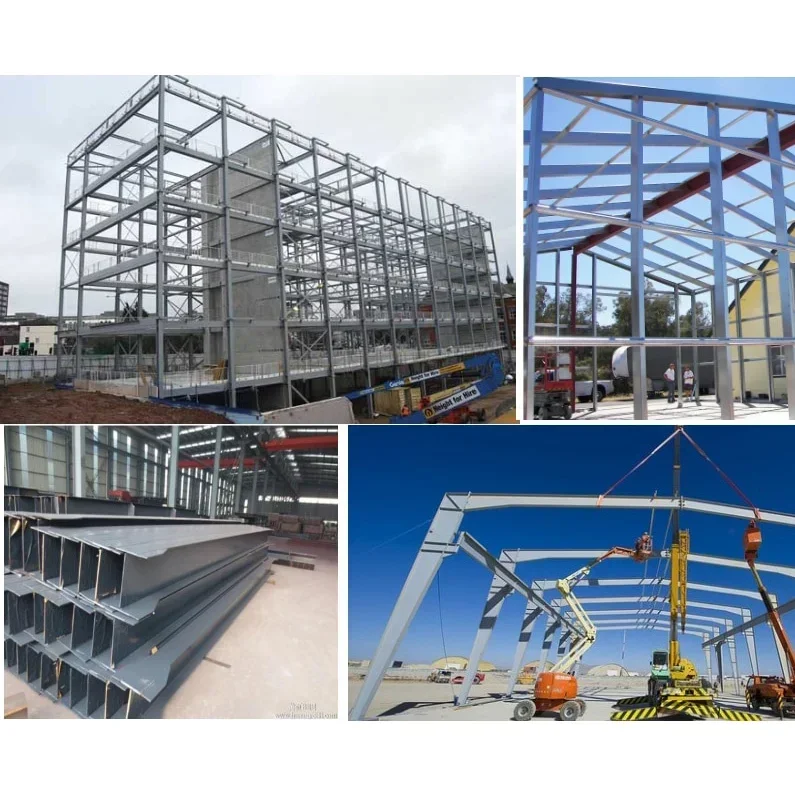-
Advantages of Using Steel Frame Warehouses for Commercial Purposes
-
-
What are the benefits of choosing a steel structure warehouse?
-
What design and construction options are available for steel warehouses?
-
How can steel warehouses be customized to suit individual requirements?
-
What attributes contribute to the durability and longevity of steel frame warehouses?
-
Why should businesses consider using steel frame warehouses for commercial purposes?
-
Discover the efficiency and durability of a steel frame warehouse. From cost-effectiveness to versatility, steel structures offer a reliable solution for your storage needs. With quick construction timelines and minimal maintenance requirements, these warehouses provide a practical and long-lasting storage solution. The strength of steel ensures the safety of your goods while maximizing space utilization within the warehouse. Explore how a steel frame warehouse can enhance your operations and streamline your logistics processes.
Benefits of steel structure warehouse
Durability
Steel frame warehouses are known for their durability, capable of withstanding harsh weather conditions like heavy snow loads or high winds. They do not warp, split, crack, or creep and are resistant to pests such as termites.
Steel structures have a long lifespan compared to traditional building materials like wood. The material is also non-combustible, reducing the risk of fire damage significantly. This durability translates into cost savings over time due to minimal maintenance requirements.
-
Resistant to harsh weather conditions
-
Long lifespan compared to other materials
Cost-effectiveness
One significant advantage of steel frame warehouses is their cost-effectiveness in both construction and maintenance. Prefabricated steel components reduce construction time significantly, leading to lower labor costs.
Moreover, steel is a recyclable material that retains its strength even after recycling processes. This makes it an environmentally friendly option for warehouse construction while also being cost-effective.
-
Lower labor costs due to prefabricated components
-
Environmentally friendly and recyclable material
Customization Options
Steel structures offer a wide range of customization options for warehouses, allowing businesses to design spaces that meet their specific needs efficiently. From the layout configuration to interior finishes and exterior facades, customization possibilities are vast.
Businesses can easily expand or modify their steel frame warehouses as needed without compromising the structural integrity of the building. This flexibility ensures that the warehouse can adapt to changing business requirements over time seamlessly.
-
Versatile customization options available
-
Easy expansion and modification capabilities
Design and Construction Options for Steel Warehouses
Clear Span Designs
Steel frame warehouses often feature clear span designs, maximizing usable space by eliminating the need for columns within the structure. This design allows for a more open floor plan, making it easier to move equipment or goods around without obstacles. By utilizing clear span designs, warehouse owners can efficiently organize their storage layout while ensuring easy accessibility to all areas of the facility.
Clear Span Designs:
-
Maximize usable space
-
Simplify movement of goods and equipment
-
Enable efficient organization of storage layout
Flexible Layouts and Future Expansion
One significant advantage of steel frame warehouses is the ability to have flexible layouts that cater to specific operational needs. These structures allow for easy customization according to different requirements such as shelving placement or machinery setup. Steel warehouses provide the flexibility needed for future expansion. Owners can easily modify the internal layout or even extend the building's size if business operations demand more space.
Flexible Layouts and Future Expansion:
-
Allow customization based on operational needs
-
Provide flexibility for future modifications
-
Support potential expansion efforts when required
Customization Features of Steel Warehouses
Exterior Finishes
Steel frame warehouses offer a range of customization options for exterior finishes. This allows businesses to match the building's appearance with their branding, creating a cohesive and professional look. Options include different colors, textures, and cladding materials.
Businesses can select from various exterior finishes such as metal panels, brick veneer, stucco, or even glass facades to achieve the desired aesthetic. For example, a tech company may opt for a modern steel and glass exterior to reflect innovation and transparency in its brand image.
Interior Layout
The interior layout of steel frame warehouses can be customized according to specific operational requirements. From the size of individual work areas to the placement of support columns, every aspect can be tailored to meet the business's needs effectively.
Customization extends beyond just size; it also includes optimizing column spacing within the warehouse. For instance, an e-commerce fulfillment center might require wider column spacing for efficient storage and retrieval processes compared to a manufacturing facility that prioritizes maximizing floor space utilization.
Additional Features
In addition to basic structural elements like columns and beams, steel warehouses offer flexibility in incorporating additional features like mezzanines or office spaces within the structure. These additions enhance functionality and usability based on unique operational demands.
Businesses can integrate additional features, such as mezzanine levels for increased storage capacity or offices for administrative purposes directly into their steel frame warehouse design. This customization ensures that every square foot of space is utilized efficiently while catering to specific operational requirements.

The Durability and Longevity of Steel Frame Warehouses
Resilient Structures
Steel frame warehouses are known for their durability and strength. They can withstand harsh weather conditions, such as strong winds or heavy snow loads. This resilience ensures that the warehouse remains intact over time, requiring minimal maintenance. Unlike other materials like wood, steel does not rot or warp, maintaining its structural integrity for years.
Steel structures are less susceptible to pests and mold compared to traditional building materials like wood. This resistance to common issues in warehouses ensures a longer lifespan for the structure without compromising on safety or functionality. Steel is non-combustible, reducing the risk of fire damage in warehouses where flammable goods might be stored.
-
Pros:
-
High durability
-
Resistance to pests and mold
-
Non-combustible nature
-
Sustainable Choice
Opting for a steel frame warehouse also contributes to sustainability efforts due to steel being a highly recyclable material. When these warehouses reach the end of their lifecycle, the steel components can be recycled into new products instead of ending up in landfills. This eco-friendly aspect aligns with modern trends towards sustainable construction practices.
Moreover, steel frame warehouses offer flexibility in design modifications or expansions as businesses grow or change their operations over time. The ability to adapt the structure without compromising its integrity adds value by extending its usability beyond initial requirements.
Increased Efficiency
The design of steel frame warehouses allows for maximizing storage space efficiently while ensuring easy access within the facility through strategically placed doors and loading docks. These features enhance operational efficiency by streamlining processes related to storage, retrieval, and distribution within the warehouse environment.
Furthermore, due to their sturdy construction and predictable load-bearing capacity, these structures can accommodate heavy machinery necessary for manufacturing processes without concerns about structural limitations.
Advantages of Using Steel Frame Warehouses for Commercial Purposes
Maximum Storage Capacity
Steel frame warehouses provide clear spans that allow for maximum storage capacity. This means there are no columns or beams obstructing the space inside the warehouse, enabling businesses to utilize every inch efficiently. For example, a steel frame warehouse can accommodate large equipment, inventory, and machinery without any interference from support structures.
Steel frames also offer flexibility in layout design. Businesses can customize their warehouse interiors based on their specific needs and requirements. Whether it's creating designated storage areas, installing mezzanine floors for additional space, or optimizing shelving systems for better organization, steel frame warehouses can be tailored to suit various commercial purposes effectively.
Cost Savings Over Time
One significant advantage of using steel frame warehouses is their low maintenance requirements, leading to cost savings over time. Unlike traditional building materials like wood that may require frequent repairs and replacements due to wear and tear or pests infestation, steel structures are durable and resilient. This durability translates into reduced maintenance costs in the long run since steel is less susceptible to damage from elements such as moisture or mold.
Moreover, the longevity of steel frames contributes to cost-effectiveness by minimizing the need for regular upkeep and renovations. Businesses investing in a steel frame warehouse benefit from its robust construction that withstands harsh weather conditions and environmental factors without deteriorating quickly. As a result, companies can allocate resources more efficiently towards core business operations rather than continuous building maintenance.
-
Pros:
-
Clear spans maximize storage capacity.
-
Customizable designs cater to specific needs.
-
Low maintenance requirements lead to cost savings over time.

-
Summary
The benefits of steel frame warehouses are vast, encompassing durability, customizability, and longevity. Their design and construction options offer flexibility for various commercial needs. The customization features available make them a versatile choice for businesses seeking tailored solutions. The robustness of steel structures ensures a secure and long-lasting warehouse environment, ideal for safeguarding valuable assets. The advantages of using steel frame warehouses for commercial purposes extend to cost-effectiveness, sustainability, and ease of maintenance.
Considering these factors, opting for a steel frame warehouse can be a strategic decision for businesses looking to invest in a reliable and efficient storage solution. The combination of strength, adaptability, and economic benefits positions steel warehouses as a top choice in the realm of commercial storage facilities.
Frequently Asked Questions
What are the benefits of choosing a steel structure warehouse?
Steel structure warehouses offer durability, cost-effectiveness, and faster construction compared to traditional buildings. They provide flexibility for future expansions and have higher resistance to natural elements like fire and pests.
What design and construction options are available for steel warehouses?
Steel warehouses can be designed in various sizes, layouts, roof styles, and exterior finishes. Construction options include pre-engineered building systems or custom designs tailored to specific needs.
How can steel warehouses be customized to suit individual requirements?
Steel warehouses offer customization through features like insulation options, lighting configurations, office spaces integration, mezzanine floors addition, and branding elements incorporation based on the business's unique needs.
What attributes contribute to the durability and longevity of steel frame warehouses?
The durability of steel frame warehouses is attributed to their resistance against corrosion, pests infestation, mold growth; ability to withstand extreme weather conditions; minimal maintenance requirements; long lifespan exceeding traditional building materials.
Why should businesses consider using steel frame warehouses for commercial purposes?
Businesses benefit from using steel frame warehouses due to their quick construction time leading to faster occupancy; cost savings in terms of maintenance expenses over time; adaptability for different industrial applications; compliance with safety regulations ensuring a secure working environment.






